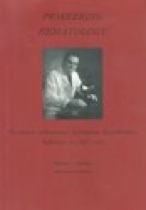Excerpts from Pioneering Hematology
“I was never much of a cook. Whenever my wife Jo found me at the kitchen stove, mixing up another concoction, she had good reason to be alarmed. The Carney Hospital had meager laboratory facilities, so the kitchen at home pinch-hit as a lab for my research in coagulation and bleeding disorders. I’d mix up batches of animal brains on the burners of the stove and store leftover animal parts in the refrigerator. This worked well enough until the morning Jo opened the refrigerator to be greeted by an exploding cow’s stomach. That was the day that particular lab of mine closed for good.”
More excerpts:
“From 1934 to 1938, two important events occurred which dramatically advanced hematology. Alexander Weiner discovered a new red blood cell factor in Rhesus monkeys. Fifteen percent of humans had this factor. Another physician, Philip Levine, concluded that hemolytic transfusion reactions were due to incompatibilities of the Rh-factor. If a patient with the Rh factor (Rh negative) received a transfusion from someone with the Rh factor (Rh positive), an antibody was induced that was capable of causing destruction of the Rh-positive cells. Levine also concluded that, during pregnancy, Rh positive cells from the fetus passed through the placenta into the maternal circulation. If the mother were Rh negative, she would form an anti-Rh-antibody which, on passing through the placenta, would destroy the Rh positive cells of the infant and result in its death. This remarkable discovery explained the cause of hemolytic disease of the newborn. It was also observed that Rh-negative mothers became increasingly sensitized with each pregnancy. The problem was especially pronounced in Catholic hospitals, where multiple pregnancies were common.”
“In a seemingly unrelated event in America, veterinarians were puzzling over a bleeding disorder which was observed when cattle were dehorned. Astute investigators found that the disorder occurred only in cattle that had eaten spoiled sweet clover. Further studies revealed that the spoiled sweet clover contained a chemical substance known as coumadin. When coumadin was administered to animals, it caused a vitamin K deficiency followed by a coagulation defect evidenced by abnormal bleeding. In other words, coumadin inhibited vitamin K, and this interfered with the production of prothrombin.”
“Both these findings were widely publicized in the medical literature and gave new life to the field of hematology. In a medical landscape best described as dismal, these events were a light on the horizon, and showed how research could be applied to achieve real results.”















